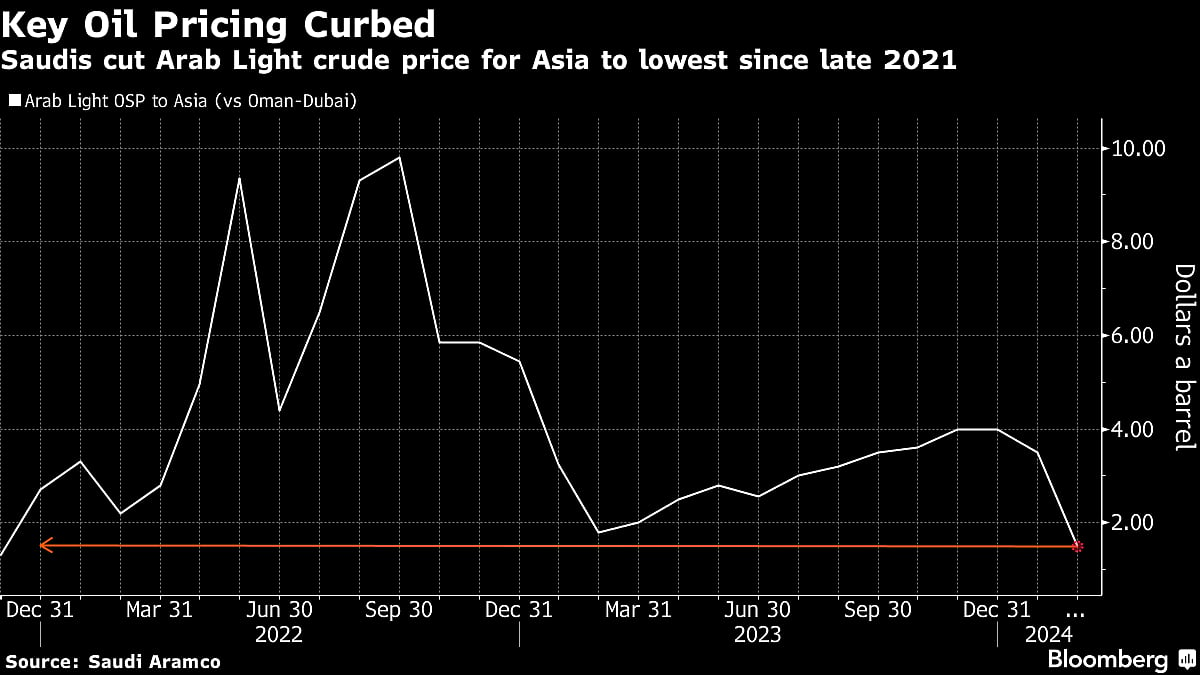Deep Oil Price Cut By Saudis Highlights Soft Physical Market
A bigger-than-expected cut in official oil pricing to Asia by OPEC+ leader Saudi Arabia has reinforced signs of softer physical crude market in the largest consuming region.

(Bloomberg) -- A substantial cut in official oil pricing to Asia by OPEC+ leader Saudi Arabia has reinforced signs of softer physical market in the key region.
Saudi Aramco cut the official selling price for its flagship Arab Light crude to a $1.50-a-barrel premium to the regional benchmark for February, the lowest level since November 2021. The $2-a-barrel reduction was deeper than had been foreseen, and follows a weakening of spot differentials for Middle Eastern crudes due to lackluster Chinese appetite and increased global supplies.

Oil posted the first annual loss since 2020 last year as non-OPEC+ production expanded, and traders looked ahead to slower growth in demand, including from key importer China. Crude’s weakness has prompted Riyadh to make a deep voluntary output cut, as well as complementary reductions from other members of the Organization of Petroleum Exporting Countries and its allies. Traders are also wary global growth may slow in 2024, restraining oil consumption.
“Amidst the weakening of the global economic outlook and the fading of seasonal demand strength, it has not come as much of a surprise that Saudi is cutting its OSPs so deeply,” said Serena Huang, lead Asia analyst at Vortexa Ltd. The move is key for defending the nation’s market share, she said.
Saudi pricing has been lowered in line with the spot market, which may potentially boost margins for customers that use the kingdom’s cargoes as their baseload, refiners and traders said. Aramco’s pricing is typically followed by other major producers in the Middle East such as Kuwait and Iraq.
Still, at least three Asian customers said the price drop was unlikely to lead to requests for incremental deliveries from the Saudis as there are cheaper, rival supplies still available in the spot market. Two Chinese buyers said they won’t be lifting any term cargoes from the Saudis for next month.
Last month, Chinese refiners said they would receive less Saudi crude on-month for January loading. Asian crude buyers also turned elsewhere after the kingdom reduced pricing of its key grade by only half the amount forecast.
However, European refineries may request more volumes from Saudi Arabia following the cut in OSPs and increasingly expensive alternative grades, such as Norway’s Johan Sverdrup, according to traders involved in the market.
European buyers will be also very keen to take Saudi deliveries from Sidi Kerir, the export terminal on Egypt’s Mediterranean coast at the northern end of the Sumed pipeline. That’s because many refiners are worried about potential delays for tankers going through the Red Sea following Houthi attacks, traders said.
Crude futures declined on Monday after the pricing announcement. Global benchmark Brent — which collapsed by 19% in the final quarter of 2023 as the market outlook darkened — dropped by as much as 3.4% to $76.10 a barrel.
--With assistance from Sarah Chen and Sherry Su.
(Updates with views on European refineries in eighth and ninth paragraphs.)
More stories like this are available on bloomberg.com
©2024 Bloomberg L.P.